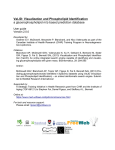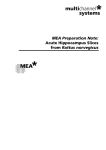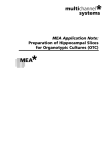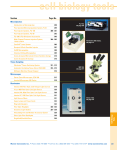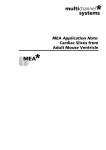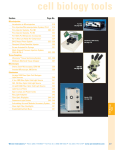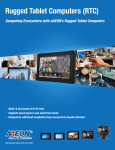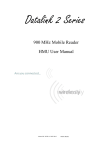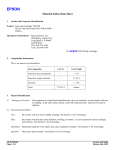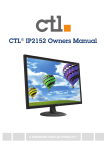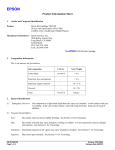Download Vibratome Series 3000 Plus Tissue Sectioning System
Transcript
Vibratome Series 3000 Plus Tissue Sectioning System Bergen County Technical Schools Biotechnology Lab Room 224A Vibratome Series 3000 Plus Tissue Sectioning System Safety Sheet 1. Samples should be handled according to good laboratory procedures and methods in order to prevent accidents. 2. When using this instrument, always wear gloves and safety goggles. 3. To avoid electrical shock, never open any instrument panels. 4. Ensure that the correct power source (115 VAC) is used to power the instrument. 5. Prior to powering on the instrument, be sure that power switch is in the off position to avoid injury once power is applied. 6. Connectors on the rear of the instrument could carry a potentially hazardous electrical current. Make sure all connections are made prior to connecting to a power source. 7. The instrument should be checked prior to use for leaks in the bath. If a leak should exist, the instrument should not be used until fixed. 8. When filling or emptying the bath, care should be taken to avoid spilling on other surfaces of the system. 9. To prevent corrosion or deterioration of the bath container and installed parts and sensors, the solution should not be left in the bath when shut down or not in use. 10. The sectioning blade presents a severe injury hazard. a. Always use caution when installing a new sectioning blade. They are extremely sharp. b. The instrument does not contain a forward position sensor, so rapid vibration could mask its actual position. c. The blade will not be hindered by objects in its path, including the assembly, specimen mount, or fingers. Always ensure that the blade is correctly installed prior to sectioning. d. Having the blade in the incorrect position can damage the blade, specimen, or user. 11. When disposing of blades, place tape over the sharp edge to avoid cuts. Always dispose of blades in a designated sharps bin. 12. Food and drinks should not be placed on or near the instrument. Vibratome Series 3000 Plus Tissue Sectioning System Information Sheet The Vibratome 3000 Plus Sectioning System provides a versatile means of sectioning fresh or fixed animal or plant tissues. The instrument employs a vibrating blade principle, which allows for sectioning without the need of freezing or embedding the sample. The creation of artifacts, the alteration of morphology, the destruction of enzyme activities, and other deleterious effects inherent in freezing or embedding procedures are thus avoided. The patented vibrating blade principle moves the sectioning blade edge in a reciprocating arcuate path as it penetrates the specimen (See diagram below). The reduced effective edge angle from the transverse movements, together with the lateral distribution of the cutting edge penetrating pressure, minimize elastic deformation of soft tissue specimens that are simply held or capsulated in position during sectioning operations. Uniform sections, as such, can be made of delicate soft tissue specimens. Sections are made free of observable compression distortion in the direction of the cut, and preservation of ultrastructure is maintained in the sections from a lack of cellular damage on their surfaces. The instrument uses normal injector type razor blades for sectioning. Sectioning takes place in a liquid bath. The liquid serves to lubricate the sectioning blade, to maintain specimen temperature, and to enhance or preserve desirable characteristics of the specimen. It also serves to facilitate the easy retrieval of the sections generated. The instrument is able to be run in three different modes: semi-automatic with manual stage movement, single section, or automatic serial sectioning. The amplitude of the blade vibration, the speed of blade advance, and the presentation angle of the blade are all user selectable to achieve optimum results with varied specimens in each mode. Diagram of the method of action used for the Vibratome 300 Plus Diagram of Sectioning Vibratome Series 3000 Plus Tissue Sectioning System Instrument Information Sheet Instrument Overview 1. Power Switch (on rear) 2. Magnifier Window 3. Sectioning Blade Holder 4. Specimen Bath 5. Control Panel (see next page) 6. Specimen Mount 7. Stage Height Adjustment Knob Control Panel Overview 1. Blade Holder Direction Switch a. Up to advance the blade b. Down to return the blade to original position 2. Blade Holder Speed (0 – 10) 3. 4 Line LCD Menu Display 4. Magnifier Light On/Off Switch 5. Pause Blade Switch 6. Blade Amplitude Switch (0 – 10) 7. LCD Menu Option Buttons (1 – 4) Specimen Holder Overview 1. Blade Holder Assembly Swivel Adjustment Knob 2. Blade Spring Clamp 3. Specimen Mount Position 4. Specimen Mount Swivel Adjustment Knob 5. Blade Holder (blade placed underneath) 6. Specimen Vise 7. Specimen Bath Foot Pedal for Blade Advancement Overview 1. Blade Return 2. Blade Advancement Vibratome 900R Bath Refrigeration Unit Overview 1. Power Button 2. Current Indicator 3. Electrical Fault Indicator 4. Heatsink Overtemp Indicator 5. Temperature Control Panel 6. Set Temperature Buttons 7. Peltier Cooling Stage Vibratome Series 3000 Plus Tissue Sectioning System Quick Start Guide Instrument Setup Mounting a Sample Two types of mounting can be performed: direct or adhesive mounting. 1. Direct Mounting a. Use this method of mounting a specimen if it is rigid enough to be held in place by the specimen vise without the clamp causing damage. b. Specimen that are rigid, but less self supporting (like a leaf) can be sandwiched in the vise between support strips or soft materials such as balsa wood, elder pith, or Styrofoam, and then sectioned as a unit. i. The supporting material chosen should section easily and may be separated once the section is in the bath area after sectioning. 2. Adhesive mounting NOTE: Be sure to wear gloves and safety glasses whenever working with an adhesive medium. a. Fragile or difficult to position samples may be adhesive mounted directly or indirectly to a specimen mounting block. i. Mounting can be done using an adhesive substance, such as cyanoacrylate base specimen adhesive. b. Cyanoacrylate is a good adhesive for biological samples. i. Ensure that enough adhesive mounting medium is used to completely attach the sample to the surface. ii. Ensure that the section is blotted dry, and that the surface it is being mounted on is clean and free of debris. c. Specimen small enough to fit on one of the surfaces of the specimen mounting block can be attached directly. d. If the specimen area is too large, an intermediate glass slide may be used. Installing and Preparing a Blade NOTE: The blade should always be installed with the instrument power OFF. NOTE: Three types of razor blades can be used for sectioning: single edge injector type blades, double edge blades, or the diamond blade. Choose the one appropriate for the sample being sectioned. 1. To install a blade: a. The spring clamp is used to secure the blade in place. i. Pull the wireform release lever located on the front of the blade mount body down to separate the spring clamp from the body. ii. See Instrument Information Guide for description of parts. b. Hold the blade by the blunt end between your index finger and thumb, and insert with the cutting edge facing down, into the blade mount body while the spring clamp is open. i. The blade should be set fully against the stop in the back of the blade holder. c. Close the spring clamp to lock the blade into place. 2. Setting the blade angle: a. The blade angle is set by rotating the blade holder in its transverse mounting rod. b. The blade can be set for 0° - 50°, but optimal sectioning will occur in the 15° – 25° range. i. 20° is the blade angle best suited for most applications. ii. Some sections will need different blade angles for optimal sections. Compression or rubbing marks will occur on specimen with too small an angle, and non-uniformity of sections and possible tearing of the sample may occur with too large an angle. Specimen Bath Preparations The specimen bath is used to lubricate the blade when sections are being generated, prevent drying or heating of the specimen, enhance and preserve desirable characteristics of the sample, and to facilitate the easy retrieval of the fragile sections generated. 1. A wide range of bath fluids can be used to fill the bath, including PBS, alcohols, hydrocarbons, distilled and deionized water, glycerols, mineral oils, and formalin. a. For fresh animal tissue, normal saline is best. b. For fixed animal tissue or botanical samples, distilled or deionized water is best. 2. Bath liquid should be brought to the appropriate temperature externally before sectioning. a. For most applications, having the liquid at a temperature just above freezing is best. 3. Temperature can also be controlled by the 900R system (see next section). 4. Once the blade has been set to the appropriate presentation angle, the bath should be filled to a level where the blade edge is submerged in approximately 34mm of the liquid. a. This will allow the section to either ride directly upon the curved front of the blade holder or float in front of the blade itself. Using the 900R Bath Refrigeration System 1. Use a screw driver to remove the screw that mounts the specimen vice to the post that lowers or raises the specimen. 2. Place the adapter for the peltier bath into the hole and tighten with an allen wrench. 3. Line up the hole in the peltier bath with the mounting post. 4. Push the handle (located on the front of the bath) forward to lock the bath into place. Make sure it is tightened into place before proceeding. 5. Mount the sample to the stage (similar to the way it was previously explained. 6. Fill the bath with the appropriate fluid. 7. Turn on the unit, and set the temperature for the bath. a. The stage will need to be cooled using a water source while the peltier stage is cooling the bath water. 8. Section samples as described in the following pages. 9. Once finished sectioning, drain the bath, and remove the peltier stage from the instrument. 10. Replace the original mounting vise in the unit. Turning On the Instrument and Setting Section Parameters 1. To turn on the instrument, press the Power Switch, located on the rear of the instrument (left side). a. The LCD Screen on the front of the instrument will show a start up screen. Press the Option 4 Button to move to the Main Menu. NOTE: Once power is applied to the instrument, all of the buttons are active. Be careful of all moving parts once the power is on. 2. The main menu screen has 4 options for the user: Manual Mode/ Set up, Move Stage, Single Cut, and Serial Cut. 3. Press the Option 1 Button on the Instrument Control Panel for Manual Mode/ Set up. a. Press the Option 2 Button to enter manual mode. i. When this is selected, manual mode is engaged and specimen height can be adjusted using the Specimen Height Control Knob. ii. Once completed, press the Option 4 Button for Done. b. Press the Option 3 Button for modes of operation. i. In this screen are two options: Bypass and Ultra Cut. ii. Choosing Bypass causes the stage to drop after a section is cut on the return stroke so that there is no possibility of the blade to touch the specimen. iii. Choosing Ultra Cut maximizes the cutting power applied to the sample using pre-set frequency and amplitude settings. 1. This setting is not optimal for all sections. iv. Return to the Main Menu by pressing the Option 4 Button for Done. 4. Press the Option 2 Button on the Instrument Control Panel for Move Stage. a. Press the Option 1 Button, Move Stage Maximum, to access the options to move the stage to its upper or lower max/min height. i. Pressing Option 1 will move the stage to its upper maximum height limit. ii. Pressing Option 2 will move the stage to its lowest minimum height limit. iii. Pressing Option 3 will reset the stage value at 0, so that any additional stage height movements can be recorded from that point. iv. Pressing Option 4 returns to the previous screen. b. Press the Option 2 Button, Move Stage, to access options to move the stage to a position using finer control. i. For this setting, depending on the mode, the sample can either be stepped in a continuous motion, or step in 0.5 micron steps. ii. Pressing Option 1 will move the stage up, in either the continuous or stepwise manner depending on the setting. iii. Pressing Option 2 will move the stage down, in either the continuous or stepwise manner depending on the setting. iv. Pressing Option 3 will reset the stage value at 0, so that any additional stage height movements can be recorded from that point. v. Pressing Option 4 returns to the previous screen. 5. When ready to begin sectioning, turn on the lamp by pressing the Light On Switch, and prepare to use the 2x Magnifying Window. Sample Sectioning Setting Up Section Parameters Sections can be cut in three ways: manually, single sections, or serial sections. General rules for speed and amplitude settings for samples: • A rigid sample may be sectioned with a low amplitude-to-speed ratio (high speed setting). • A soft specimen is best sectioned with a high amplitude-to-speed ratio (high amplitude setting). o Speed and amplitude settings should be adjusted as needed. To Manually Cut Sections: 1. Ensure that the sample is placed on the mount and the blade has been installed. 2. Set the Speed that the blade should move at by turning the speed knob to the appropriate setting. 3. Set the Amplitude that the blade should move at by turning the amplitude knob to the appropriate setting. 4. Set the Section Thickness by rotating the section thickness knob. a. Ex. If the knob is set at 45, and the user wants a 10µm section, the knob should be turned to 55 to obtain 10µm sections. 5. Once the settings are ready, press the Front Foot Pedal to advance the blade. a. To stop the blade from advancing, press the Pause Switch, or press the Back Foot Pedal to reverse the blade path. 6. Repeat for as many sections as are needed. To Cut a Single Section: 1. Ensure that the sample is placed on the mount and the blade has been installed. 2. Set the Speed that the blade should move at by turning the speed knob to the appropriate setting. 3. Set the Amplitude that the blade should move at by turning the amplitude knob to the appropriate setting. 4. Press the Option 3 Button on the Instrument Control Panel for Single Cut. a. Press the Option 1 Button to increase the thickness of the section. Thickness will be displayed on line 3. i. Line 1 also shows the number of cuts that have been made. b. Press the Option 2 Button to decrease the thickness of the section. Thickness will be displayed on line 3. i. Line 2 also shows the overall thickness of sections that have been cut. c. Press the Option 3 Button to move the stage into position for sectioning. i. This line will also show the thickness of the section to be cut. 5. After pressing the Option 3 Button to move the stage into position for the cut, press the Front Foot Pedal to advance the knife. a. To stop the blade from advancing, press the Pause Switch, or press the Back Foot Pedal to reverse the blade path. b. Repeat any of these steps as necessary to acquire additional sections from the sample. 6. Press the Option 4 Button to return to the Main Menu. To Cut Serial Sections: 1. Ensure that the sample is placed on the mount and the blade has been installed. 2. Set the Speed that the blade should move at by turning the speed knob to the appropriate setting. 3. Set the Amplitude that the blade should move at by turning the amplitude knob to the appropriate setting. 4. Press the Option 4 Button on the Instrument Control Panel for Serial Cut. a. Press the Option 1 Button to increase the thickness of the section. Thickness will be displayed on line 3. i. Line 1 also shows the number of cuts that have been made. b. Press the Option 2 Button to decrease the thickness of the section. Thickness will be displayed on line 3. i. Line 2 also shows the overall thickness of sections that have been cut. c. Press the Option 3 Button to move the stage into position for sectioning. i. This line will also show the thickness of the section to be cut. 5. After pressing the Option 3 Button to move the stage into position for the cut, press the Front Foot Pedal to advance the knife and begin sectioning. a. When the foot pedal has been pressed, and serial sectioning is in progress, stop the sectioning by pressing the Option 4 Button to stop the sectioning. i. If the stop option is selected while a cut is in progress, the instrument will complete cutting the section in progress, and then return to its original position. 6. Each section to be cut will require the front foot pedal to be pressed, but the sample stage will automatically move into position after each section is cut. 7. Once the sectioning is stopped, press the Option 4 Button to return to the Main Menu. Initial Gross Trimming Prior to sectioning, gross trimming of the specimen top surface with the sectioning blade to achieve flatness is required. 1. The top surface of the specimen should be adjusted to be horizontal by either tilting the specimen vise or tilting the specimen mounting block. 2. The blade should be advanced to the specimen, and stopped before making a cut so that the height of the specimen can be adjusted to just below the blade edge. 3. Trimming of the section can then be performed by trimming the sample until the entire area of interest is included in a complete section. a. It is suggested that sections be made in this step in 50µm intervals. b. For unknown samples, a low speed and medium amplitude should be used. c. If the specimen permits, the speed and section thickness can be increased to reduce trimming time. 4. Once gross trimming is completed, continue to the Normal Sectioning section. Normal Sectioning Once gross trimming has been completed, and the complete area of interest is exposed, normal sectioning can be performed by following one of the three methods above for sectioning. NOTE: The first few sections that are created using the user settings should not be used, as these are normally used to adjust settings and optimize sectioning procedure. The lamp and magnifier can be used to closely examine the sections as they are being cut. Section Retrieval The sections that are created will be floating on the top of the liquid bath. Sections may be retrieved in a number of ways. 1. For microscopic applications, sections can be delivered to a glass slide by aspirating the section with a small glass dropper if it will not damage the section (only for rigid or stable samples). 2. If the sample is not stable enough to be removed using a dropper, a fine sable brush or glass rod can be used to manipulate and move the sample to a glass slide. 3. Once the section is on the slide, it can be adhered using albumin or another mounting medium. The sample can also then be stained and cover slipped based on the needs of the individual samples. Shutting Down the Instrument 1. Make sure the sectioning blade is returned to its original starting position. 2. Turn off the light on the magnifier. 3. Turn off the instrument power by pressing the Power Switch, located on the rear of the instrument. 4. Only after the power is off: a. Remove the sectioning blade from its holder. It is to be disposed of in a designated sharps container, NOT a regular garbage can. b. Remove the sample from its mount. The sample can be stored for future use, or disposed of according to proper disposal techniques for the sample. c. Remove all liquid from the sample bath and dispose of properly. Rinse out the bath, with the last rinse being clean water, to ensure that it is clean for future use. i. There is a drain located on the rear of the instrument. Tubing is installed to allow liquid to be drained from the instrument using this drain. d. Make sure the area around the instrument is clean!
























